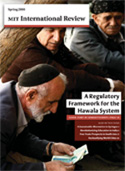2009 Online Exclusives
A Response to Professors Gillespie and Agnew on "Finding Osama bin Laden"
By Murtaza Haider
Professors Gillespie et al. while writing in MIT International Review have not only identified Parachinar, the town where Osama Bin Laden may have been hiding, but they have also pinpointed the three buildings that they think are likely to be Bin Laden's hideout. Since I am from the Northwest Frontier Province, I find it a little odd that Osama may be hiding in the only Shiite majority town in the entire tribal region of Pakistan.
The geography professors at UCLA may have used spatial analysis to determine the probable hideout of Osama; they certainly overlooked history and anthropology, which would have explained the gory sectarian rivalries between the Shiites of Parachinar and the Sunni supporters of Osama bin Laden. This is yet another example of technical analysis devoid of any understanding of the local socio-cultural and political contexts.
Parachinar is a small town of approximately 20,000 individuals, who are almost exclusively Shiites and belong to Turi and Bangash tribes. The Sunni tribesmen from North Waziristan agency along with other militants from Arab countries and the Caucasus have been attacking the Shiites over the past two years, which has resulted in the death of hundreds of Shiites. In addition, since the Sunni tribesmen control the ground access to Parachinar from Peshawar, the supply of food, medicines, and other necessities to Parachinar have been interrupted for months, forcing the doctors to operate without anesthesia. The power and water supply, which have been restored only recently, also remained suspended.
I find it hard to believe that after having hundreds, if not thousands, of Shiites murdered by the followers of Osama bin Laden, the Shiites of Parachinar would like to aid and abet Osama bin Laden.
It is sad to see that the press in North America has largely ignored this tragedy that has been unfolding in Parachinar over the past two years. It took faculty and students from UCLA to put Parachinar on the map, but only for the wrong reasons.
Professors Gillespie et al. assert that "One of the most important political questions of our time is: Where is Osama Bin Laden?" Even when the crisis in Darfur has killed hundreds of thousands of innocent civilians; the relentless bombing by American drones and the fighting in the Pakistan's tribal areas has forced half a million civilians to live in deplorable conditions in refugee camps; and the hunger and disease faced daily by the global poor, the authors still believe that locating Osama is "one of the most important political questions of our time." Even if Osama Bin Laden is found, what answers could he provide that would make the world become a better place?
Lastly, I am concerned that if the UCLA professors are taken seriously by the trigger-happy NATO forces, who certainly lack ground intelligence in the tribal areas and cannot tell friend from foe, the Shiites of Parachinar may have to fend off bombs dropped from American drones, while they are fighting for their survival against the Taleban on the ground.



